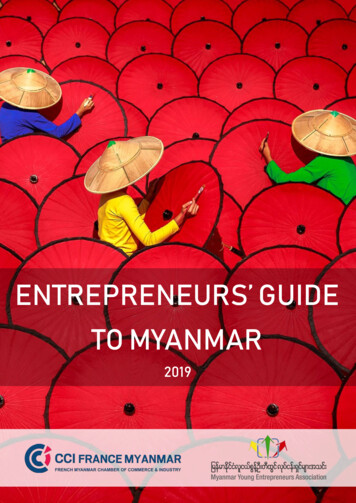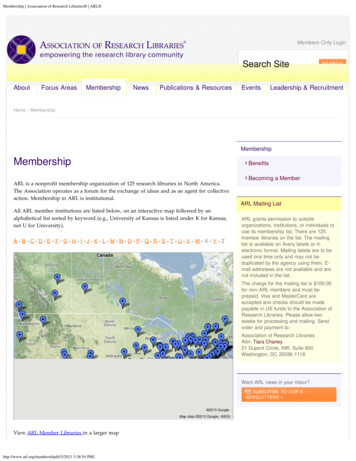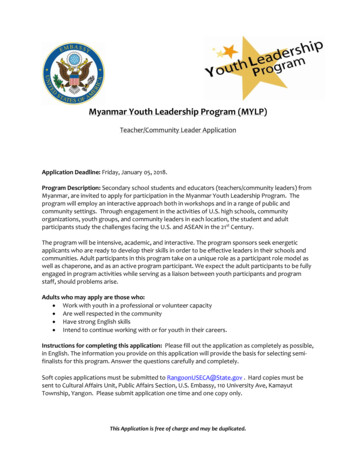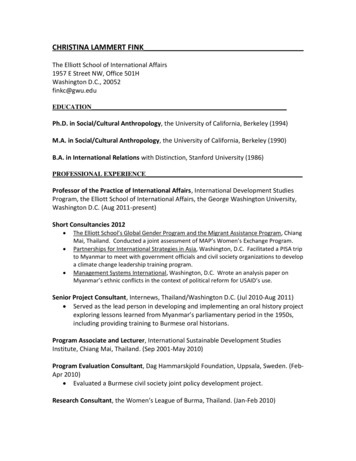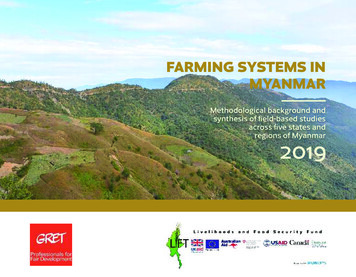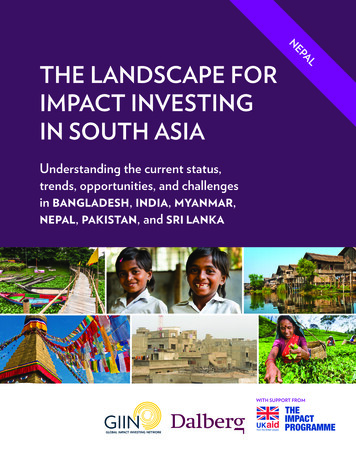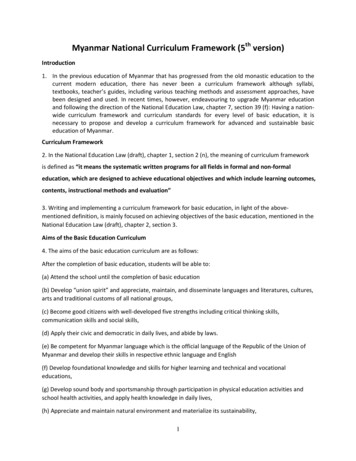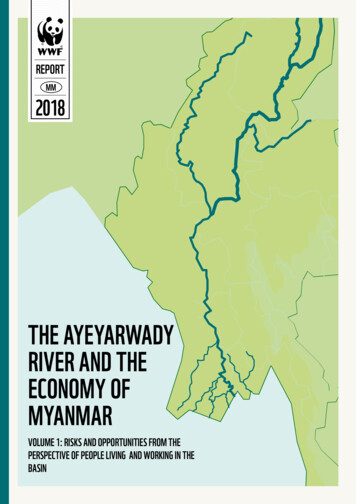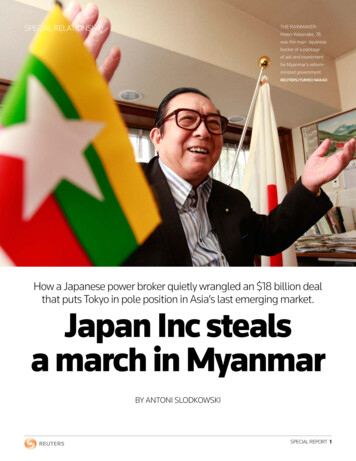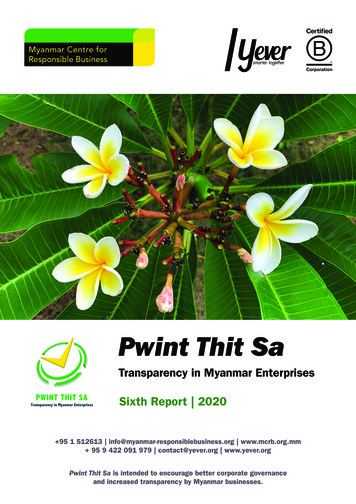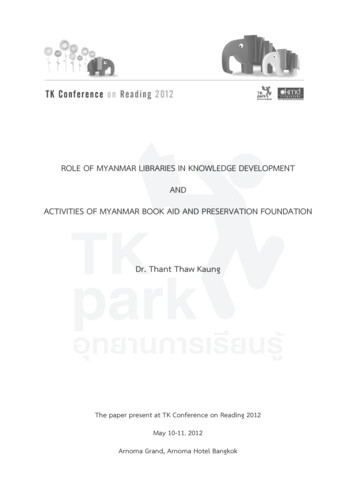
Transcription
ROLE OF MYANMAR LIBRARIES IN KNOWLEDGE DEVELOPMENTANDACTIVITIES OF MYANMAR BOOK AID AND PRESERVATION FOUNDATIONDr. Thant Thaw KaungThe paper present at TK Conference on Reading 2012May 10-11, 2012Arnoma Grand, Arnoma Hotel Bangkok
ROLE OF MYANMAR LIBRARIES IN KNOWLEDGE DEVELOPMENTAND ACTIVITIES OF MYANMAR BOOK AID AND PRESERVATION FOUNDATIONDr. Thant Thaw KaungOne of the last countries opened up to the world, Myanmar is facing manychallenges to develop its human resources.In order to improve human resourcedevelopment, our current government has made changes and improvements, but manychallenges remain. Our ministries of Education and Health along with INGOs and NGOs willplay major roles in making these changes.This paper will emphasize the following topics;1. Role of Myanmar libraries in human resource development2. Current education policy on knowledge development3. Challenges in promotion of knowledge development4. Activities of our two foundations, Myanmar Book Aid and Preservation Foundationand Nargis Library Recovery, in helping library development.1. Role of Myanmar Libraries in Human Resource DevelopmentMyanmar’s history of libraries extends back to the ancient Bagan dynasty (11th-13thcentury A.D). Most libraries then were related to pagodas and monasteries and were knownas Pitika-taik . Their collections were of palm leaf or paper folded manuscripts.Modern libraries were developed during the British colonial period and four typescan be found in Myanmar:1.) National Libraries and branches2.) Academic Libraries1
3.) Public Libraries4.) Special Libraries1.) National LibraryThe National Library was founded in 1952 after taking over the collection of theBernard Free Library, founded in 1883 by Sir Charles Edward Bernard, the Lt. Governor ofBurma.It is now under the Ministry of Culture. However, the library has not receivedproper attention by successive governments. Even a proper building was not constructed bythe government as it has been moving from one building to another. Therefore, many userstoday are more familiar with the Universities Central Library than the National Library inMyanmar. Even though it has a good collection of rare books on Myanmar, very few peopleuse them.There is a legal depository requirement for all the local publication;consequently it has a nearly complete collection of local publications. However, becauseof budget deficits and improper buildings since 1962, this library remains unattractive amonglocals, scholars and officials. A new National Library is being built in our new capital, Nay PyiDaw, due to open in 2013, over (700,000) books have been collected in Yangon’s and NayPyi Daw’s National Libraries. They are considered to be reference libraries, so no borrowingis permitted. Branches of the National Library are in all seven States: Mon, Shan, Rakhine,Kachin, Chin, Kayah, and Kayein, and they are also connected to their State Museums. Wealso have branches in the (7) Greater Regions of Myanmar, such as Yangon, Mandalay andAyeyarwaddy.Our National Library offers library training courses and a Diploma course whichstarted in 2010. Moreover, digitized versions old texts are shared with the digital collectionsamong State and Greater Divisional libraries. At present, a new National Library Act is beingdrafted and will be passed by Parliament this year. It has received grants from ASEAN COCIto digitize all their rare books.2
2.) Academic LibrariesAmong our academic libraries, Rangoon University Library was the first and earliestfounded in 1927, it is now a research and reference library. It once was reputed to havebest collection in Southeast Asia of historical and cultural materials. Destroyed during theSecond World War, it was afterwards renovated and reopened in 1951, then reorganized asthe “niversities’ Central Library (“CL) in 1964 according to a new education system.During the military Socialist Government era (1962-1988), new libraries weredeveloped in the Yangon University. The faculty of Yangon University was divided intoInstitutes e.g. Institute of Medicine, Yangon Institute of Technology, each with academiclibraries. Due to financial constraints, only a few new foreign books were bought. Severebudget cuts in education retarded growth of these libraries as new books and journals couldnot be purchased. After 1988 when even less emphasis was given to education, our librarydevelopment was stifled. During this period, new university libraries were built in differentstates and divisions, they were stocked with few books, funds were not allocated. Howeverduring this current 2012-13 budget year, our library budgets have been increased doubled, asign the current government values more highly on our educational development.Our Universities Central Library (UCL) has the best collection in Myanmar of rare andancient manuscript collections in the form of Palm Leafs and Paper Folded Manuscripts.Microfilm and digital projects funded from abroad, along with conservation support, havepreserved them in good condition. UCL also has exchange programmes with (12) overseauniversities libraries and hence has the best collection in the country.Apart from UCL, there are currently (164) academic libraries. They are under (13)different ministries, such as the University of Medicine, Science and Technology Universities,etc. The funds for state-run libraries come from the respective ministry’s budget which isvery low. For example, our annual National Library budget is only about Kyat four million(about US 5,000 annually). For lack of funding, keeps these libraries buy very few foreign3
language books. In fact, many libraries rely entirely on donations, which prevent ourlibraries from subscribing to online databases or online eBook resources. However, thecurrent government is finally emphasizing the importance of online libraries. We hopedonors will help us gain access to these expensive online databases.Because of lack of new books in State libraries, most readers rely on private librariessuch as the British Council Library and the American Center Library. Most State Librarieshave had to develop their collections from donations by NGOs, INGOs and visiting scholars.3.) Public LibrariesAccording to the statistics of Ministry of Information, there are over (50,000) publiclibraries all over the country; however most of these are merely pitiful village libraries.However, we have no proper audit or accounting of active libraries. The Ministry ofInformation is working to promote reading habits among children and new librarydevelopment. In May 2010, they formed an NGO called Myanmar Library Foundation tohelp the ministry in library development and promote reading habits among adults also.Myanmar Library Foundation’s job is to survey the country, to construct new libraries andpromote reading habits among citizens. Awareness is being gained about various media asthe Foundation gathers famous authors and even film actors to serve on the Foundation’sboard. Meanwhile, public libraries are being built and literary talks are designed to helppromote reading habits among citizens throughout Myanmar.Apart from these government-public libraries, there are a number of private librarieswhich are very successful, especially the British Council Library, the American Centre Libraryin Yangon & Jefferson Centre in Mandalay, in addition to small private libraries in smallercities, such as Saya Zaw Gyi Library in Pyarpon & Insein’s Dr. Chit Maung Library. Many ofMyanmar’s 1,800 monastic schools have libraries as well. Poor students normally go tothese monastic schools and these libraries require much help.4
4.) Special LibrariesMyanmar has special libraries as follows:1. Department of Medical Research (both Upper and Lower Myanmar)2. Library under Department of Promotion and Propagation of Religion3. Library under Public Affairs Commission4. Traditional Medicine Library5. Library at Central Research OrganizationIn addition to these four types of libraries, Myanmar Library Science Course which isadministered by the Ministry of Education generates qualified librarians. Moreover, MyanmarLibrary Association (a local NGO), also plays a crucial role in training of qualified librarians.Myanmar Library Science CourseEven though there are many challenges, Myanmar still has over 800 qualifiedprofessionally trained librarians who graduated from our Myanmar Library Science Course,founded in 1974 by Dr. U Thaw Kaung. At present, these courses are conducted in all majoruniversities of Myanmar and award the Diploma, B.A, M.A and PhD in Library Science. Theselibrarians are qualified to work either in university or school libraries. Some of them areeven working in oversea UN organizations and Library of Congress.Myanmar Library AssociationMyanmar Library Association is a local NGO under the sponsorship of Ministry ofCulture; it plays a crucial role in continuous training of the librarians in Myanmar. It wasfounded as a local NGO in 1994 by Dr. U Thaw Kaung also. Its purpose is to conduct trainingcourses for librarians, to share information and stimulate public awareness about the role oflibraries and librarians. It conducts library training courses every 3 months. Anybody canenroll in these courses and basic training is given for new local librarians. Each course lasts5
for two weeks, and occasionally foreign librarians give talks and offer training to librarians.Since it is an NGO, it has more flexibility in linkage with foreign organizations.2. Current Education Policy on Knowledge DevelopmentAs I mentioned earlier, the current government is making many changes andimprovements on knowledge development. As of 31st March 2012, the current governmentcelebrated its first anniversary and noted the followings changes in knowledgedevelopment.2.1 Education budget has been raised from 2.4% in 2010-11 to 4.7% in 2011-12 .Total of Kyat 310,401 Millions (US 340 Millions) in 2011-12 has been raised to Kyat 617,214Millions (US 740 Millions) in 2012-13 fiscal year. This increment is almost double of lastyear. Everyone welcomes this improvement; however, this budget is still low compared withother countries in Southeast Asia. According to our economists, a developing country likeMyanmar should have at least 14-20% of the total budget allotted to the education sector.2.2 Private School Law has been passed. With this law, private schools can openand students can attend these schools and sit for government exams. Previously, studentshad to attend state schools to make their attendance official, then also attend theseprivate schools for real study. No longer is it necessary to attend a state school.2.3 At the higher education level, one more year has been introduced. Previously,university students attended only three years to get a degree. Under the new system, theymust study for four years to get a degree, which is the international standard, a welcomechange.2.4 Salaries of teachers working in rural and remote areas were increased two-foldssince April’12. “nder the present scheme, most teachers are getting about US 60 permonth, but even this low pay is not guaranteed to every teacher.6
2.5 English proficiency skills have improved. At present, TOEFL-like test is aprerequisite for all the MA and PhD students.2.6 Openness is improving as we link up with overseas universities from the West, forinstance, a John’s Hopkins “niversity program will reopen (JH“ had a center from 19551962). Moreover, foreign professors are returning to teach at our universities. At present,one German professor is teaching at the Geography Department in the Yangon University.2.7 There are plans to get online education via internet. However, the country willneed tremendous help from outside as the budget will not pay for expensive onlinedatabases.2.8 More state scholars will be sent abroad as the government is giving moreattention on linkages with western world.2.9 More openness in the parliament can be seen nowadays as Members ofParliament are raising questions about education, most of which have been answered by theMinister of Education.3. Challenges in Promotion of Knowledge DevelopmentEven though Myanmar has an official 95% literary rate and various efforts were madeon library development, we have so many challenges in promotion of readership in ourlibraries.3.1) Due to development of technology (ICT), many students are spending their timeon internet chatting or playing computer games. They are not developing reading skills.3.2) Because of low funding, very few libraries are equipped with quality books. Mostbooks in Myanmar libraries are outdated or damaged.3.3) Due to our tough examination system, students do not have time to read orstudy extracurricular materials. Most of the students are fully occupied with exam7
preparation; they have to attend schools while also attending private tuitions until very latenight, so they have no time to read for pleasure.3.4) Lack of electricity in rural areas makes rural libraries inefficient. Most ruralpeople only have free time at night, so readership will be increased if our electricitybecomes more reliable. (* 70% of total population is living in rural area)3.5) Poverty (currently 26%) is another important factor which keeps students fromfinishing their education. Most villagers should pass the 4th Standard but we have a veryhigh percentage of dropouts as families need children at home to work. At present, eightmillion students are attending primary, middle and high schools all over the country butonly 400,000 students are attending at universities. In other words, only 5% of studentsattain a university education which in itself is very problematic, still.3.6) Even though a library may be properly set up, it often fails to run properly dueto lack of a proper library board.3.7) This year’s education budget of 4.7% of the total government spending is verylow compared with our neighboring countries, and most funds are being spent onconstruction of universities and colleges, very little investment is made on teacher trainingand library development. Therefore, in relation to budget, we are more interested in howthe budget is going to spent than how much budget is going to allocated for educationsector.3.8) Lack of experienced teachers: UNICEF recently conducted a survey of over 200primary schools in Myanmar and found many teachers use Rote Learning or one way ofteaching, called Chalk and Talk or Passive Learning . Questions are rarely asked and ifasked they are normally closed questions rather than open questions. Teachers rarelyrecommend libraries to use also.3.9) ”ery low teachers’ salary: Myanmar teachers until this year were paid aroundKyat 25,000 per month (about US 30), among the lowest in the world, so to sustain8
themselves they must give private tuition in extra school hours. In fact, too many teacherssurvive only through private tuition.3.10) English proficiency skills are still very low.3.11) Current average schooling is less than 4 years comparing with 10 years inneighboring countries, due to high dropout rates in our rural areas.3.12) Teachers/Students Ratio: We have severe inequality in our teachers/studentsratios. In the rural area, the ratio is 1:30, while in urban schools the ratio can be 1:70 ormore, especially among our more famous schools.4. Role of Myanmar Book Aid and Preservation Foundation (MBAPF) andNargis Library Recovery Foundation(NLR) in Knowledge Development1.) Brief History of MBAPF and NLRMyanmar was hard hit by Cyclone Nargis in May 2008 and over 130,000 peopleperished during the cyclone. Among the damage and destruction, over 2,000 libraries andschools were destroyed. MBAPF was contacted by friends of Myanmar around the world.One was Dr. John Badgley, a Burma specialist and retired curator from Cornell UniversityLibrary who had surveyed our university and college libraries in 1987-88. Dr. Badgleysearched for donors of books and in December, 2008, persuaded a large online book seller,Thrift Books, to donate a million books. Nargis Library Recovery (NLR) was formed afterNargis in USA with board members comprised of seven retired professors, businessmen andphilanthropists. It gained tax exempt status as well as a license of exception to the severeUS sanctions against Myanmar.MBAPF has been formed in Myanmar with a boardcomprising of senior librarians, businessmen and influential persons in 2002 to preservebooks and assist libraries. Dr. Badgley and I serve on the boards of both organizations.I would like to thank to my father Dr. U Thaw Kaung who gave us the guideline andadvice on our foundation activities. As mentioned earlier, he is recognized as Father of all9
librarians in Myanmar as he has vast knowledge, contacts and enthusiasm to help ourcountry’s libraries.He founded Myanmar Library Science Course, Myanmar LibraryAssociation and worked as chief librarian for Universities Central Library for over 40 years.His works were recognized by many oversea organizations and hence won for FukuokaAcademic Prize in 2007, the first prize for a librarian in Asia. He acts as Chairman of ourfoundation also.With combined efforts of NLR and MBAPF, funds for shipping of containers wereobtained by NLR’s Board Members. Initially the American President Line donated containerberths for 300,000 books and was targeted to cyclone-affected areas in the Delta; howeverwe have expanded to cover the entire country with our activities.2.) Mission StatementFoundation was formed with the following mission statements.- Provide global knowledge throughout the country by distributing over a millionbooks.- Reconstruct over 2,000 libraries damaged by Cyclone Nargis.- Equip libraries with not only books but desks and benches as well as laptops andshelves.- Enhance community support via library reader workshops—to host workshop &follow-up training by professional librarians and teachers.3.) Partner DonorsCurrently, these donors are supporting our programme.1. Thrifts Books, U.S.A2. Opportunity Foundation, Thailand3. American President Line, U.S.A4. University of Washington Library Gift Programme, U.S.A10
5. Cornell University Library Gift Programme, U.S.A6. Institute of Southeast Asia, Singapore7. National Library of Australia, Australia8. “nited Nation Women’s Guild of ”ienna9. Montana Library Association10. World Vision, Myanmar4.) Current Activities of NLR and MBAPF- Sorting books by subject and donate to needy libraries. Currently, over 750libraries have received over 500,000 books from the foundation. 400,000 books are inEnglish and 100,000 books are in Myanmar language.- Funds raised by selling 30% of English books to buy new Myanmar languagebooks for those libraries in towns & villages where English levels are low. These fimds areraised through Book-Buffets arranged by Myanmar Book Centre’s staff.- Select libraries for reconstruction and repair. We constructed a library/communitycentre in Thin Kan Gon village in Lutputta Township with assistance from UNWA, and overthirty village libraries funded by World Vision in Bogale Township. Numerous studentmanaged libraries exist because of our book donations, and even funds for renting space insome instances.- Library Training Course: With support from Myanmar Library Association, we areable to give training to village librarians. Training on How to run a small library hasbecome very popular among our librarians.- Library Readers’ Programme: With the support from volunteer from UK Australiaand the USA, we are promoting English language proficiency skills such as presentation,negotiation, communication and debate skills trainings in communities, both in small citiesas well as Mandalay and Yangon.- Teachers Training Workshops: As mentioned earlier, lack of experienced teacherswith proper teaching skills is one of the major challenges in Myanmar. In 2011, three11
teachers training workshops were conducted by Sue Simpson from USA and Gayle Holmesfrom Australia in Bogalay, Mandalay and Yangon. They created very dynamic workshops oneffective use of simple reading books as well as how to plan lessons and be creative in theclassroom. Their workshop methods are new for Myanmar teachers and who thoroughlyenjoyed the training. They already are being used in their classes. Responses to LibraryReaders workshops has been very good, so more workshops will be conducted within 2012and in the future, if we can secure additional funding.5.) Type of BooksDonation from Thrift Books consists of wide area of subjects such as Children Books(Kids to Teen Readers), Self Development Books, Reference Books, Fiction and Non-fictionand Higher Academic books. Most are used books still in good condition and usable inMyanmar. At present, we have imported 600,000 books and another 400,000 books are yetto be imported. These books are appreciated by the urban libraries, community centresand school libraries receiving them. The CEO of Thrift Book visited Myanmar and has agreedto donation another million of books in the future.Other university libraries donated academic and reference books. Two US UniversityLibraries have gift programmes and were willing to join in our project: Cornell UniversityLibrary and University of Washington State Library; additionally, the Institute of SoutheastAsia in Singapore and the University of Canberra, as well as private scholars around theworld have contributed books to our project. They are especially valuable for ouruniversity libraries which have been scarcely funded.As mentioned earlier, 30% of donated books are sold, with permission from donors.The purpose of selling these books is to raise funds to buy Myanmar language books. Ourbooks are sold in book fairs called Book-Buffets where customers buy bags, which theyfillas full as they can. These are exciting events for people in cities where Englishlanguage books are in demand, but very hard to find. Our motto is Right Books to Right12
People so that Myanmar language books can be purchased with funds we raise, thendonated to rural libraries.6.) PartnersIn order to run effective operation in library development, MBAPF partners withmany other local NGO, INGO and local volunteers. We partner with World Vision, TharaparLibrary, Active Youth, Kanbawza Youth and other local NGO to get effective distribution ofour books. We also partner with Community Service from International Schools which areactive in volunteerism. Distribution of the books, usage of books, teachers trainingworkshops, and library readers’ programmes are assisted by these NGO and INGO volunteers.We also partner with influential persons and monks in library development;examples being Venerable Sitagu Sayadaw and Venerable Dhammapiya Sayadaw, whosupport our foundation activities. Because of their help, more people are aware of ouractivities. Moreover, these Sayadaws emphasize in their preaching the value of reading.Finally, our key and most important partner is Nargis Library Recovery Foundationbased in USA. They have been a continuous supporter and donated most of the books,which enables us to run our foundation activity smoothly.Our key challenge is to raise fund for shipping books, which costs over US 6,000 forone 40’ container for shipping to Myanmar. American President Line donated the freightcharges for our first six containers, subsequent shipping has been paid for by our board ofdirectors.7.) Donated LibrariesCareful selection of the libraries is a key factor in donating of our books. Reliabilityof the library, accountability and transparency of the donated libraries are considered keyfactors to be considered to donate. Moreover, presence of a strong library board andeffective librarians are also important factors in success of a library. Supporting letter from13
an influential person or a monk is necessary to get donated books. After donation, properphotographic evidence and also follow-up by a foundation staff is necessary. All the booksmust be stocked on open shelves. Equal access to the books must be given as well.We have found two types of librarians: Some librarians are readers but do not wantto share, they always protect their books. But, other librarians are good readers plus theyare willing to share and offer good customer service. We prefer to deal with the latter typeof the librarian because success can be gained with this type of librarian. A librarian shouldnot only concentrate on books but also should be creative and should offer good customerservice. Therefore, the role of efficient and effective librarians is very important in successfulrunning of a good library.We are donating our books to not only state run academic libraries, national library,special collection libraries, private libraries, monastic school libraries and but also to manyvillage libraries. At present over 750 libraries have received our books. Even though westarted with the aim of donating books to delta area where cyclone hit, we are able todonate to all the States and Divisions at present. Our foundation became one of the biggestprivate NGOs donating the highest numbers of books in Myanmar.8.) ChallengesOur main challenge is raising fund for shipping books from USA to Myanmar. Wehave to thank to board members of Nargis Library Recovery, four of whom share the cost ofshipping. Each 40’ container (high cube) costs “S 6,000 from US to Myanmar. We areimporting 3-4 containers a year. Each container has about 50,000 books. In other words, itcosts only 0.12 Cent to ship a book from USA to Myanmar.Storage was another challenge that we faced. MBAPF bought two empty containersto store books in our office compound in Yangon.14
Other minor challenges are choosing the right libraries and creating accountability ofeach library. Sometimes, our donated books are not well used and they are kept in shelvesunder key. This is one of our major concerns in Myanmar society as librarians feel that thebooks are expensive and they cannot afford to lose them. We educate them to understandthat we will replenish the stock if the books are kept by readers. We have to persuade thelibrarians to let the kids touch the books, feel the books and read the books whenevernecessary. We need the kids to love the books.Forming a legal NGO is another challenge for our foundation. Until now, no newNGOs are given permits to run officially by the Ministry of Home Affairs. Therefore, there aremany organizations in Myanmar which are not recognized by the government. But, all theseorganizations including ours do not care and run their operations, de facto. In fact, all mostdomestic NGOs have full support from local communities as well as most ministries. Forexample, our MBAP Foundation has recognition and supporting letters from the Ministry ofInformation, Ministry of Social Welfare and Ministry of Education.Censorship is also another challenge for our Foundation. Because of my commercialcompany, Myanmar Book Centre, has been in the book trade for over 15 years, all theimports are done using our commercial company name.9.) Future GoalsNLR and MBAPF have become the largest book donor in three years time. Apartfrom our foundation, Asia Foundation is the only another organization which also contributeEnglish language books in Myanmar. If funding is available, we would like construct morelibraries all over the country. Moreover, we continue to donate more Myanmar languagebooks as they are more needed in village libraries. Current activities of teachers’ trainingworkshops and library reader’s programme will be expanded.15
ConclusionWe are honored to be part of a team, our two foundations help develop knowledgeamong my countrymen. My country will need a lot of human resources in the near futureas we become more transparent and strive to meet international standards. That is why weare proud of what we are able to do now. We do hope that more foreign investment andassistance can flow into the country, we would like to partner with other foreignorganizations or INGO interested in developing the education sector of Myanmar.16
libraries from subscribing to online databases or online eBook resources. However, the current government is finally emphasizing the importance of online libraries. . In May 2010, they formed an NGO called Myanmar Library Foundation to help the ministry in library development and promote reading habits among adults also. Myanmar Library .
